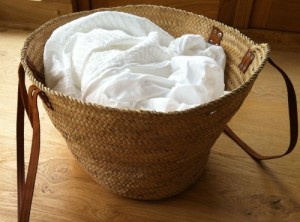 I went a little crazy & bought too many punnets of juicy strawberries last week, so they started growing beards faster than we could consume them. Inspired by Alys Fowler’s recipe for Strawberry Conserve (June issue of The Simple Things Magazine), I decided to make some jam.
I went a little crazy & bought too many punnets of juicy strawberries last week, so they started growing beards faster than we could consume them. Inspired by Alys Fowler’s recipe for Strawberry Conserve (June issue of The Simple Things Magazine), I decided to make some jam.
My initial jam-making attempts in 2011 and 2012 using plums from our tree were quite successful. The most delicious batch was the first. It caramelised slightly because I left it a little too long, while trying to work out what the setting point looked like. (Yes I know the theory about the jam developing a skin when placed on a cooled plate, but it didn’t seem that simple in our murky old kitchen.) Subsequent batches were more “textbook”, but never tasted quite as good as that first one.
This is my first attempt at strawberry jam. After two 24 hour “set aside” steps, I was into the last leg; “Boil rapidly until set, about 20 minutes.” I armed the timer, and made a cup of tea.
Then ……. I the noticed a robin feeding it’s chick on our fence. So exciting, as it is the first time we’ve seen baby robins in our garden. Their perch on the fence was soon taken over by a sparrow family – two chicks vying for mom’s attention, one nearly unseating the mother in an attempt to get to the grub. Then the blackbirds started – chick behind mom, bobbing along to lure worms out of the grass.
 While engrossed in the antics of the baby birds, the smell of caramel started to waft in from the kitchen. The timer alarm hadn’t gone off yet, but the jam had clearly progressed a little beyond the desired setting point. It was a light shade of brown. “No problem”, I thought, this might be like that first batch of plum jam that was so divine.
While engrossed in the antics of the baby birds, the smell of caramel started to waft in from the kitchen. The timer alarm hadn’t gone off yet, but the jam had clearly progressed a little beyond the desired setting point. It was a light shade of brown. “No problem”, I thought, this might be like that first batch of plum jam that was so divine.
I continued to follow the recipe; “To stop the strawberries floating to the top, allow the jam to cool slightly…. before bottling.”
Given the advanced state of caramelisation, this was a big mistake. When I tried to pick up my mixing spoon to pop the jam into the jars, the spoon had become so securely welded to the plate where it had been resting, that the plate came along for the ride. After wrestling the spoon from the plate, bottling commenced. Based on what happened later, I am not sure that I’ll ever extricate the “jam” from that bottle.
state of caramelisation, this was a big mistake. When I tried to pick up my mixing spoon to pop the jam into the jars, the spoon had become so securely welded to the plate where it had been resting, that the plate came along for the ride. After wrestling the spoon from the plate, bottling commenced. Based on what happened later, I am not sure that I’ll ever extricate the “jam” from that bottle.
As the jam cooled it became stickier, it morphed into caramel and then started to solidify into what looked suspiciously like toffee. I decided to abandon further bottling attempts, go with the flow and make toffee sweets instead.
I started popping spoonfuls of the brown gum onto a sheet of grease-proof paper. But soon golden strands of caramel started to proliferate all along the path of the spoon. As the mixture cooled, the stickiness increased, to a point where it was no longer possible to get the goo off the spoon. By this stage I was giggling uncontrollably and hubby came downstairs to investigate. He tried one of my partly-set “toffees”, which proceeded to stick his teeth together. Not sure that the toffee idea is going to work either. Oh well – I’m off to clean the pan now.
Apologies to Alys for turning her lovely recipe into such a shambles, but I just couldn’t resist those baby birds!





























